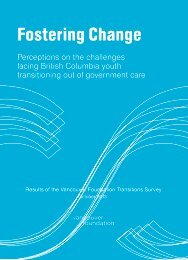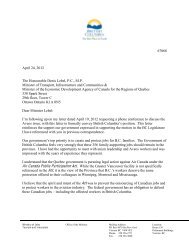from the ground up - The Tyee
from the ground up - The Tyee
from the ground up - The Tyee
You also want an ePaper? Increase the reach of your titles
YUMPU automatically turns print PDFs into web optimized ePapers that Google loves.
How to Design a Building that Restores <strong>the</strong> EarthUBC’s Centre for Interactive Research on Sustainability aims to set a newNorth American standard by actually benefitting <strong>the</strong> environment.By Katie HyslopArticle first published on March 28, 2011 by <strong>The</strong><strong>Tyee</strong>.ca.What if a building wasn’t just sustainable, butactually benefitted <strong>the</strong> environment? It’s a loftygoal, but <strong>the</strong> University of British Columbia istrying to achieve it with <strong>the</strong> construction of what<strong>the</strong>y believe will be <strong>the</strong> greenest building in NorthAmerica.Right now, <strong>the</strong> Centre for Interactive Research onSustainability (CIRS) is a two-story shell of a building:<strong>the</strong>re are no doors, <strong>the</strong> stairs are rough, andrebar and plywood are <strong>the</strong> main decor instead ofoffice furniture and potted plants. But by <strong>the</strong> time it’scompleted this June, CIRS will be more than just astylish campus building: it will meet both <strong>the</strong> LEEDPlatinum and Living Building Challenge standards,and give back more than its taking in air, water andenergy, <strong>up</strong>ping <strong>the</strong> productivity and happiness of <strong>the</strong>people who inhabit it.“<strong>The</strong> aspiration is for a regenerative building, essentiallya building that can live within its footprint,what’s available to it in terms of mass and energy flowon <strong>the</strong> site or within <strong>the</strong> site,” says Alberto Cayuela,associate director of UBC’s Sustainability Initiative,which is in charge of <strong>the</strong> CIRS project.Not just a bunch of hot airCIRS relies on a series of heating systems, including16 geo<strong>the</strong>rmal rods, solar hot water and a heaterexchange connected to <strong>the</strong> adjacent Earth and OceanSciences Building.In a climate where <strong>the</strong> amount of heating in wintermatches <strong>the</strong> cooling in summer, geo<strong>the</strong>rmal rodsDue to open in June, CIRS is being touted as a ‘regenerative’building.could successfully mine <strong>the</strong> earth’s cooling and hot airto operate a building like CIRS.But in a place like Vancouver, where <strong>the</strong> amount ofheat required is three times <strong>the</strong> cooling, a geo<strong>the</strong>rmalsystem runs <strong>the</strong> risk of taking out too much heat andcooling <strong>the</strong> earth, causing a system decline over time.To avoid this, CIRS takes as much heat out of <strong>the</strong><strong>ground</strong> as it does cool air, and relies on heat exchangerscapturing wasted air <strong>from</strong> a nearby building towarm <strong>up</strong> <strong>the</strong> rest.“(Earth and Ocean Science Building) consumes 1,600megawatt hours a year of steam <strong>from</strong> <strong>the</strong> steam plant,and 990 goes through <strong>the</strong> roof, <strong>the</strong> fume hoods. Sothat building, by law, that’s 10 air changes in hourin every fume hood, and that’s 990 megawatt hoursthrough <strong>the</strong> roof,” says John Robinson, executivedirector of <strong>the</strong> Sustainability Initiative.“We’re taking all of that heat, bringing it into CIRS,we only need 300, we’re giving 600 back to that69








